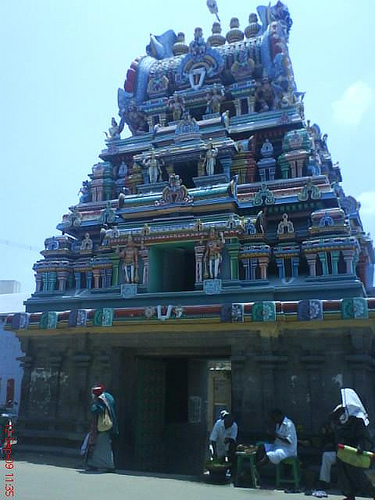This is one of the three temples within one temple ranking among the Divyadesas. There are three Divyadesas within this temple Tiru Ooragam, Tiru Neeragam and Tiru Karakam.
It is said that barring Tiru Ooragam, other temples were elsewhere earlier and were set together under one roof at a later period. Saint Tirumangai Azhwar had included all these Divyadesas in one Mangalasasanam hymn.
Karvaanam is one of the 108 Divyadesas of Perumal. Perumal appears majestically blessing the devotees with his right leg pressed on the ground with the left up.
As per Hindu legend, Vamana, a dwarf and an avatar of Vishnu, appeared here to quell the pride of Asura king Bali. Ulagalantha Perumal is believed to have appeared to king Mahabali and the Azhwars.
Six daily rituals and a dozen yearly festivals are held at the temple, of which the chariot festival, celebrated during the Tamil month of Chittirai(March?April), is the most prominent.
Moolavar - Navaneedha Choran, Kalvan
Thayar - Kamalavalli Thayar, Thamarayal
Blessing Pose - Standing Posture Facing North With Sreedevi and Bhoodevi
Vimanam - Pushkala Vimanam
Theertham - Gowri Theertham, Tharathara Saras
Ulagalandha Perumal Temple is a temple dedicated to Vishnu located in Kancheepuram, Tamil Nadu, India. Constructed in the Dravidian style of architecture, the temple is glorified in the Divya Prabandha, the early medievalTamil canon of the Azhwar saints from the 6th - 9th centuries AD.
It is one of the 108 Divyadesam dedicated to Vishnu, who is worshipped as Ulagalantha Perumal and his consort Lakshmi as Amudavalli. The temple is believed to have been built by Pallavas, with later contributions from Medieval Cholas, Vijayanagar kings and Madurai Nayaks. The temple is found in Big Kanchipuram and situated close Kamakshi Amman Temple.
This Divyadesam is also situated inside the Pragharam (Inner-wall) of Ooragathan Temple, Kanchipuram.The Perumal in this sthalam is Thirukkaar vaanar. Kaar means clouds and Neer means rain (or) water.
The God explains to
the world that the water in this world is the resemble of him and the
Kaar (the black clouds which gives rain) to the world is also one of
his reflection and clouds which is found in the sky is also the
reflection.
Without water, the World cannot survive. So, he comes to the World as rain and make all the things to survive.So, Sriman Narayanan explains that he himself is
the black clouds which gives the rain for the humans and all things to
survive. So, this perumal is called as "Thirukkaar"
Do:
- Do pray your Ishta Devata before pilgrimage to Temple.
- Do contact Temple Devasthanam information centre for enquiry, temple information and for Pooja details etc.
- Do reserve your travel and accommodation at Temple well in advance.
- Do bath and wear clean clothes before you enter the temple.
- Do concentrate on God and Goddess inside the temple.
- Do maintain silence and recite your Istamantram to yourself inside the temple.
- Do observe ancient custom and traditions while in Temple.
- Do respect religious sentiments at Temple.
- Do deposit your offerings in the hundi only.
Don't s:
- Do not come to Temple for any purpose other than worshipping of God and Goddess.
- Do not smoke at Temple.
- Do not consume alcoholic drinks at Temple.
- Do not eat non-vegetarian food in the Kshetram.
- Do not approach mediators for quick Darshanam. It may cause inconvenient to others.
- Do not carry any weapon inside the temple.
- Do not wear any head guards like helmets, caps, turbans and hats inside the temple premises.
- Do not perform Sastanga Pranama inside the Sanctum Sanctorum.
- Do not take much time while performing Sparsa Darshanam to God in Garbhagriha.
- Do not buy spurious prasadams from street vendors.
- Do not encourage beggars at Temple.
- Do not spit or create nuisance in the premises of the temple.
